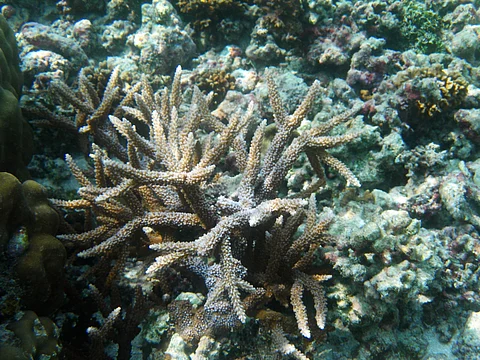

Researchers studied 3 atolls in Lakshadweep for 24 years
Coral cover in Lakshadweep declined by ~50% over 24 years, from 37.2% in 1998 to 19.1% in 2022.
Coral mortality decreased over successive bleaching events, but so did recovery rates.
Recovery of coral cover was non-linear and accelerated only after 6+ years without bleaching.
The study provides a predictive framework for reef management, but stresses that global climate action is essential.
A 24-year study has revealed how coral reefs in the Lakshadweep Archipelago are faring in the face of repeated marine heatwaves, showing a dramatic 50 per cent drop in live coral cover since 1998.
Published in Diversity and Distributions on July 17, 2025 by researchers from across India and Spain, the paper presents a complex picture: Although coral mortality has decreased over time, the overall ability of reefs to recover has also declined — unless they are given enough years free from disturbance, highlighting the importance of urgent climate action in ensuring their ecological integrity.
Lakshadweep has suffered the most in terms of coral bleaching on India’s coastline, scientists confirmed to Down To Earth in 2024.
The Union Territory of Lakshadweep Archipelago consists of 12 coral atolls. Using data from 12 reef sites across three of them — Agatti, Kadmat and Kavaratti — the team tracked coral health from 1998 to 2022.
Lakshadweep saw three marine heatwave events during the study period: 1998, 2010 and 2016. Climate phenomenon El Niño Southern Oscillation events, particularly El Niño phases, contribute to coral bleaching due to increased sea surface temperatures.
Degree Heating Weeks (DHW) is a measure used to estimate heat stress on coral reefs, based on how much and how long sea surface temperatures stay above the coral bleaching threshold. 1998 saw a DHW of 5.3, 2010 was at 6.7 DHW and 2016 saw 5.2 DHW — meaning 2010 was the most severe one of the three.
Live coral cover dropped from an average of 37.24 per cent to 19.06 per cent over the 24-year period, the researchers found. But unlike early bleaching events, where up to 28 per cent of cover was lost, the 2016 heatwave caused just a 1.8 per cent decline in absolute coral cover on average.
This doesn’t necessarily mean the reefs are adapting; fewer corals died because fewer vulnerable species remained in later years. The researchers suggested that many heat-sensitive corals may already have disappeared from the ecosystem, leading to lower mortality rates.
“The emergent composition after three successive bleaching events is dominated by typically ‘stress tolerant’ genera like Porites, but also includes mixed assemblages including Isopora, Favia, Pocillopora and Goniopora,” the authors wrote in the paper.
One of the study’s most striking findings is that coral recovery accelerates only after a six-year gap between bleaching events. Shorter recovery windows, like the one between 2010 and 2016, limit the ability of fast-growing genera such as Acropora to bounce back.
The findings offer a predictive framework for conservation in a region with no formal reef management. By identifying which reef areas are most likely to suffer and which are most likely to recover, the study can help prioritise protection and restoration efforts.
But the authors are clear-eyed about the limits of local action: “Ultimately, the global reach of the climate crisis demands responses at both global and local scales, using instruments appropriate to each.”
They warned that even the most resilient reef communities cannot withstand increasingly frequent heatwaves indefinitely.